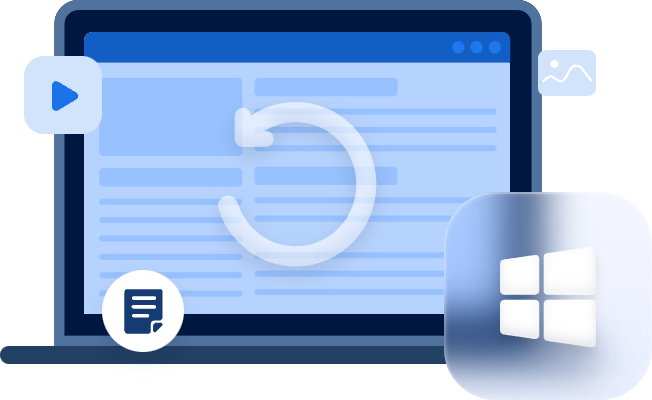How to Recover Inaccessible Files with MyRecover
Discover the art of recovering inaccessible files with this guide, addressing user cases, reasons for inaccessibility, and the prowess of MyRecover. Navigate through the complexities of data loss and learn to regain access to your files effectively.
User Case: Navigating the Frustration of Inaccessible Files
Imagine the scenario: you attempt to open a crucial document or cherished photo, only to encounter the dreaded message that the file is inaccessible. This frustrating user case is all too common, disrupting your workflow and causing unnecessary stress. In this guide, we provide insights and practical solutions to navigate the challenges of inaccessible files.
Reasons Why Files Become Inaccessible:
Understanding the potential reasons behind file inaccessibility is crucial for effective data recovery:
✅ Corruption of File System:
File systems can become corrupted due to abrupt system shutdowns, power outages, or other unforeseen events, rendering files inaccessible.
✅ Malware or Virus Attacks:
Malicious software can infect files, encrypting or corrupting them and making them inaccessible to users.
✅ Hardware Failures:
Failures in storage devices, such as hard drives or SSDs, can result in inaccessible files. Physical damage or wear and tear may contribute to these failures.
✅ Accidental Deletion or Formatting:
Accidentally deleting files or formatting storage devices without proper backup can lead to data loss and file inaccessibility.
How to Recover Inaccessible Files with MyRecover:
Empower yourself with MyRecover to retrieve inaccessible files effortlessly:
✅Advanced Scanning Algorithms:
MyRecover employs advanced scanning algorithms for a thorough search, ensuring the identification of inaccessible files even in complex scenarios.
✅Selective Recovery:
Preview recovered files before restoring them, allowing you to select and recover only the files you truly need.
✅User-Friendly Interface:
The intuitive design of MyRecover makes it accessible to users of all experience levels. No technical expertise is required for effective file recovery.
Operating Steps for MyRecover:
1. Download and Install
Visit the official MyRecover website, download the tool, and follow the installation instructions.
2. Initialize Scan
Start quick scan for faster results or deep scan for a more comprehensive search.
3. Choose Storage Source
Select the storage device or location from which files are inaccessible.
4. Preview and Recover
Preview the recovered files and choose the ones you wish to restore. Click "Recover" to complete the process.
How to Recover an Inaccessible Drive Quickly
If you encounter the dreaded scenario of an inaccessible drive, where important files seem out of reach, fear not—recovery is possible. To reclaim access to your drive, follow these steps:
1. Check for Physical Issues
Ensure that the drive is connected properly and that cables are intact. Try connecting the drive to a different port or using another cable to rule out hardware issues.
2. Use Windows Check Disk Utility
Windows provides a built-in Check Disk utility to identify and fix errors on drives. Open Command Prompt as an administrator, type chkdsk /f X: (replace X with the drive letter), and press Enter. This utility can repair file system issues causing inaccessibility.
3. Assign a New Drive Letter
If the drive appears in Disk Management but doesn't have a drive letter, it may be inaccessible. Right-click on the drive in Disk Management, choose "Change Drive Letter and Paths," and assign a new letter.
4. Try Data Recovery Software
If the above steps don't resolve the issue, consider using data recovery software like MyRecover. Install the tool, select the inaccessible drive, and follow the recovery steps to retrieve your files.
Remember, if the drive is physically damaged, consult a professional data recovery service. Always prioritize creating backups to prevent future data loss.
Conclusion:
In conclusion, the frustration of inaccessible files can be transformed into relief with the right tools and knowledge. MyRecover emerges as a powerful ally in the journey to retrieve lost data. Explore the depths of data recovery, armed with insights into the reasons behind inaccessibility and the capabilities of MyRecover.
FAQs: Recovering Inaccessible Files
1. Can MyRecover recover files from a corrupted external hard drive?
Yes, MyRecover is designed to recover files from various storage devices, including corrupted external hard drives.
2. What types of files can be recovered using MyRecover?
MyRecover supports the recovery of a wide range of file types, including documents, photos, videos, and more.
3. Does MyRecover work on both Windows and Mac systems?
MyRecover now only siupportWindows operating systems, providing a versatile solution for users.
4. How long does the file recovery process with MyRecover usually take?
The recovery time depends on factors such as the size of the storage device and the extent of data loss. MyRecover offers quick and deep scan options to suit your needs.
5. Can MyRecover recover files deleted due to a virus attack?
Yes, MyRecover can recover files deleted or corrupted due to a virus or malware attack, restoring your data even in challenging scenarios.

